Turning 18 opens the door to driving independence, but finding the right instruction can feel overwhelming. Nearly 2.3 million teens get their licenses each year, yet many struggle to choose between different lesson types and schools.
We at floridanewdriver.com know that driving lessons for 18-year-olds require careful planning and research. The right instructor and program can make the difference between confident driving and years of anxiety behind the wheel.
What Driving Lesson Types Work Best for 18-Year-Olds
Eighteen-year-olds have three main lesson options, each with distinct advantages and costs. Traditional in-car lessons with certified instructors remain the gold standard and offer hands-on experience that builds real confidence. These sessions typically cost $50-150 per lesson, with most students needing professional instruction for proper training. The immediate feedback and personalized attention from qualified instructors makes this approach the most effective for developing actual vehicle control skills.
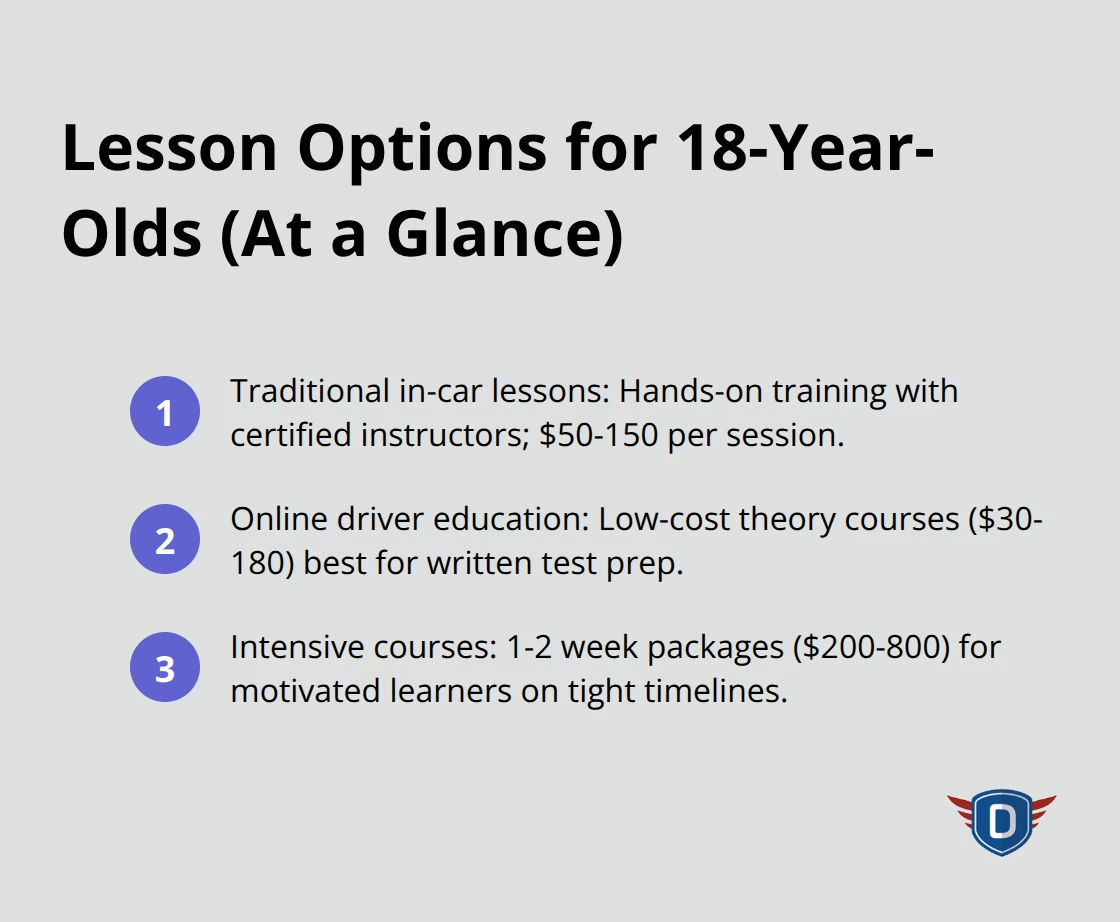
Online Driver Education Programs Provide Flexibility
Online programs work well for learning traffic laws and road signs but cannot replace behind-the-wheel training. DriversEd.com offers online curriculum, which costs significantly less than traditional lessons at around $30-180 per course. These programs excel at preparing students for written permit tests, with interactive quizzes and state-specific content that increases first-attempt pass rates. However, online education must combine with practical experience to develop actual vehicle operation skills.
Intensive Courses Accelerate the Process
Intensive courses compress months of traditional lessons into 1-2 weeks and cost $200-800 for complete packages. These crash programs work best for motivated students who can dedicate full attention to learning (particularly those with tight schedules). Success rates for intensive courses match traditional lessons when students complete the full program, but the accelerated pace can overwhelm some learners. The concentrated format suits students who move to areas with different requirements or need licenses quickly.
Traditional Lessons Build Solid Foundations
Traditional weekly lessons allow students to process information between sessions and build muscle memory gradually. Most students complete their training in 3-6 months with this approach (depending on practice frequency). This method works particularly well for nervous drivers who need time to build confidence slowly. The spaced repetition helps students retain safety procedures and develop good habits that last beyond the test.
Once you understand these lesson types, the next step involves selecting the right school and instructor for your specific needs.
How to Choose the Right Driving School
Research drives successful school selection, and smart students start with official sources rather than advertisements. Your state DMV website lists licensed schools and displays complaint records that reveal problem instructors. The Better Business Bureau database shows authentic customer experiences, with schools that maintain 4+ star ratings typically delivering superior instruction quality. Google Reviews and Yelp provide recent feedback, but focus on reviews that mention specific instructor names and detailed experiences rather than generic praise.
Calculate Total Costs Beyond Base Prices
Driving schools hide true costs through deceptive pricing that misleads students about final expenses. Package deals that range $200-800 often exclude road test fees, vehicle rental, and retake sessions (adding $100-300 to final bills). Schools that offer free retakes provide better value even at higher upfront costs, since students frequently need multiple attempts at road tests. Calculate total cost including potential failures rather than base lesson prices alone.
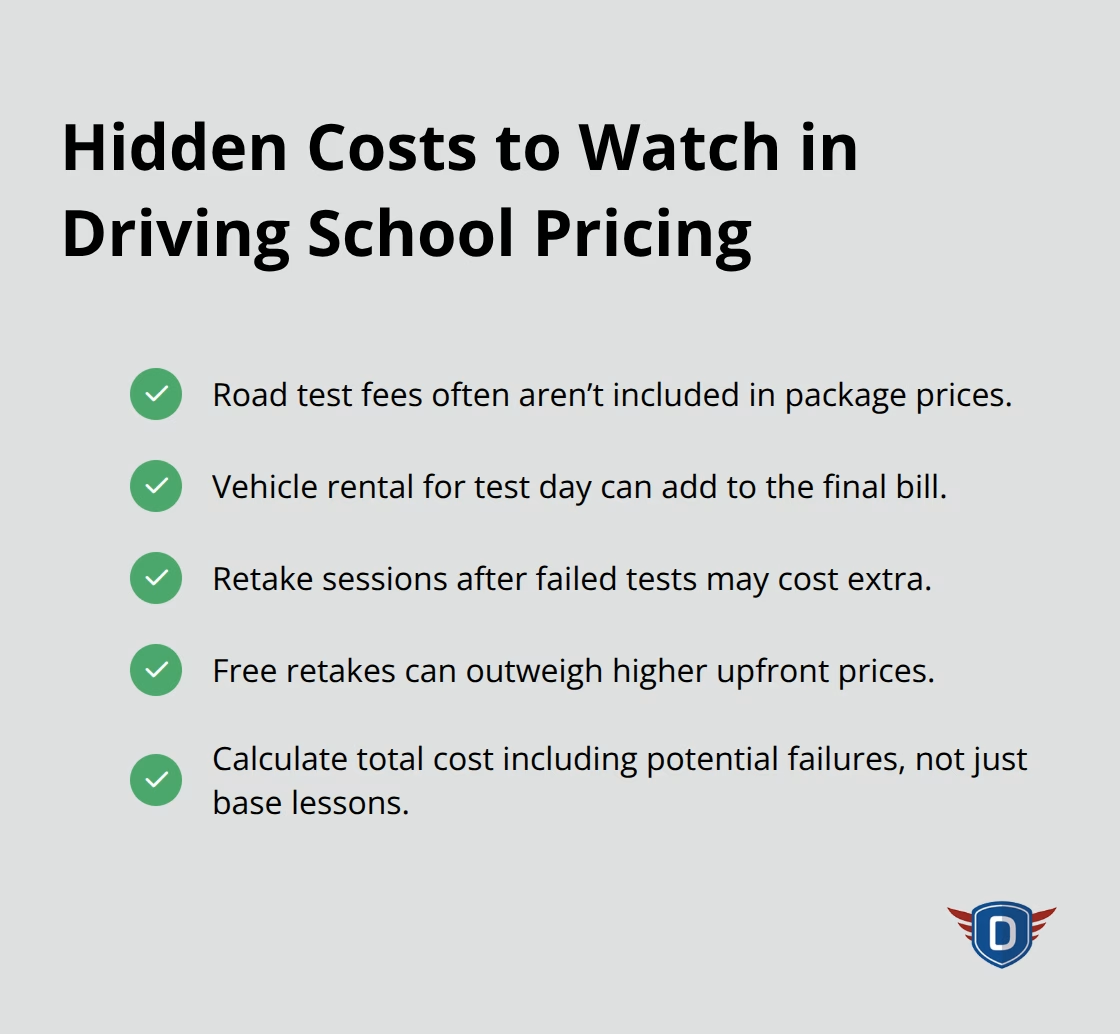
State Farm research shows students who spend $50-150 per lesson typically need 6-10 sessions, making $600 a realistic budget for complete training. Schools that quote unrealistically low prices often compensate through hidden fees or substandard instruction quality.
Check Instructor Credentials and Success Rates
Licensed instructors complete state certification programs, but experience levels vary dramatically between schools. Ask schools for specific pass rates on first-attempt road tests – legitimate schools track this data and share it openly. A good success rate for driving schools is typically above 70-80%, demonstrating superior instruction quality.
Request instructor experience details and student testimonials with verifiable contact information. DMV offices often recommend schools with consistent performance, making them valuable resources for honest recommendations about local instruction quality.
Evaluate School Equipment and Policies
Modern driving schools provide vehicles with dual controls and current safety features that protect students during lessons. Schools that use vehicles older than four years may compromise safety and fail to prepare students for modern driving conditions. Ask about vehicle maintenance schedules and insurance coverage before committing to lessons.
Refund policies reveal school confidence in their instruction quality. Schools that offer partial refunds for unused lessons demonstrate flexibility, while those with strict no-refund policies often prioritize profit over student satisfaction.
Consider online driving school options for theoretical components, which can complement in-person instruction. For first-time drivers, understanding the complete process helps in selecting appropriate programs.
After selecting your school and instructor, preparation for your first lesson becomes the next priority.
What Happens in Your First Driving Lesson
Your first driving lesson begins with a comprehensive skills assessment that determines your starting point and creates a customized plan. Professional instructors spend 10-15 minutes evaluating your knowledge of traffic laws, road signs, and basic concepts before you touch the steering wheel. This assessment identifies gaps in your understanding and helps instructors prioritize which skills need immediate attention versus advanced techniques that come later.
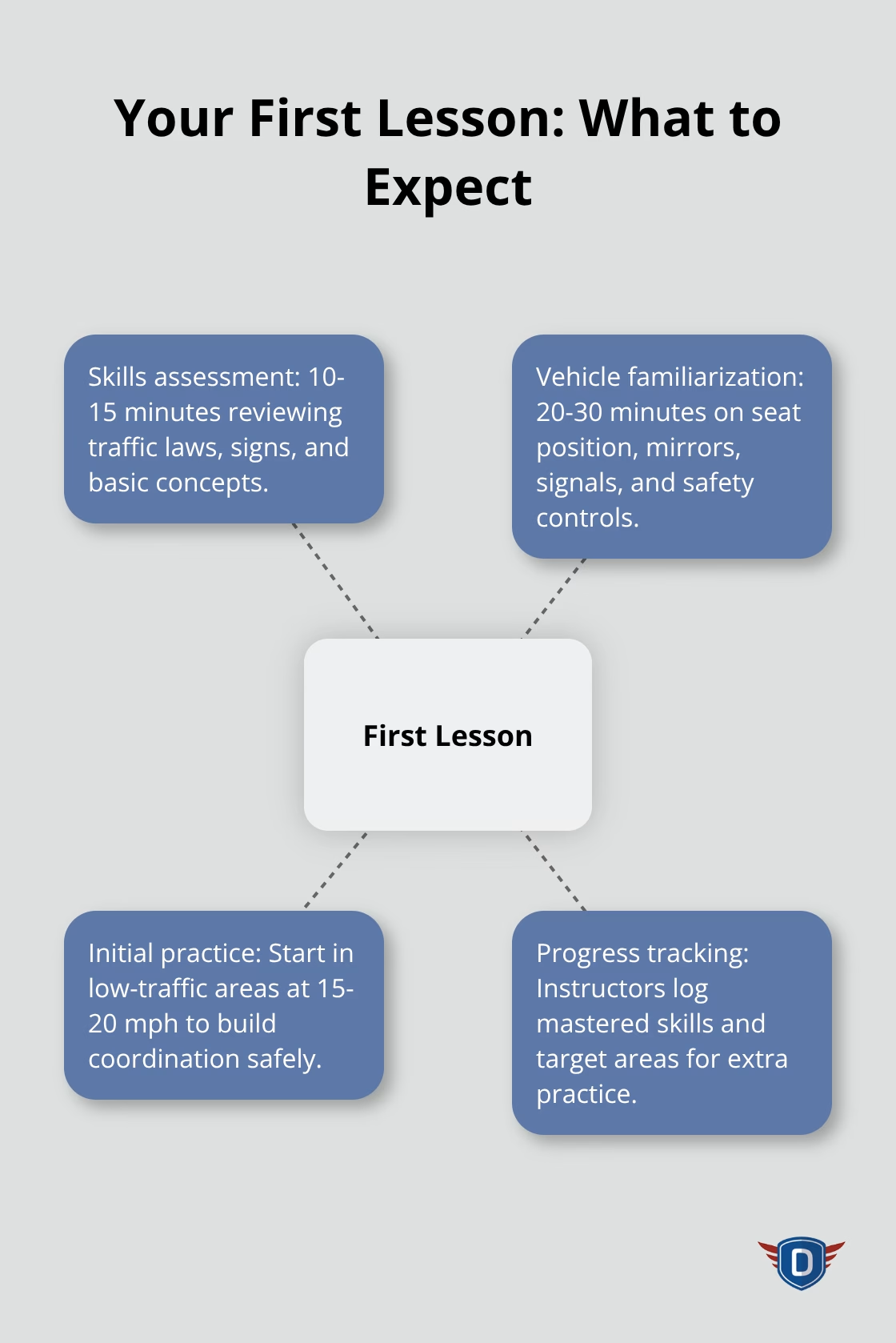
Vehicle Familiarization Sets the Foundation
Instructors dedicate 20-30 minutes to vehicle controls before you start the engine, covering everything from seat adjustment to emergency brake location. Students learn mirror positions, turn signal operation, and dashboard warning lights through hands-on demonstration rather than theoretical explanation. The National Highway Traffic Safety Administration emphasizes this systematic approach because students who master basic controls first develop better muscle memory and make fewer critical errors during actual operation.
Most instructors require students to locate and operate every control twice before movement exercises begin. This prevents dangerous confusion during real situations on the road.
Structured Practice Builds Confidence Step by Step
Initial practice occurs in empty parking lots or quiet residential streets where students can focus on coordination without traffic pressure. Instructors typically limit first sessions to 15-20 mph maximum speeds while students master coordination between steering, brakes, and acceleration. Progress tracking begins immediately, with instructors documenting specific skills mastered and areas that require additional practice in detailed logbooks.
Students who complete structured practice sessions show improved learning outcomes compared to those who jump into complex traffic situations too early. Professional instructors adjust lesson intensity based on individual progress rather than rigid timelines, which helps each student build genuine competence before advancing to challenging environments.
Assessment Results Shape Your Learning Path
Your instructor uses the initial assessment to create a personalized curriculum that addresses your specific needs and weaknesses. Students with strong theoretical knowledge but poor vehicle control receive more hands-on practice time. Those who struggle with traffic laws get additional classroom-style instruction before advancing to complex maneuvers.
This customized approach typically reduces total lesson requirements by 15-20% compared to standardized programs that treat all students identically.
Final Thoughts
Professional driving lessons for 18-year-olds follow three essential steps: select between traditional, online, or intensive instruction formats, research licensed schools through DMV records and verified reviews, and prepare for structured assessment-based learning. Students with certified instructors pass road tests at 70-80% rates compared to 45-60% for those without formal training. Professional programs create systematic skill development that prevents dangerous gaps in knowledge.
Instructors identify specific weaknesses during initial assessments and customize curricula accordingly, which reduces total lesson requirements by 15-20% compared to standardized approaches. This personalized guidance builds genuine competence rather than test-passing tricks. Students should schedule road tests immediately after they complete lessons while skills remain sharp.
Many graduates benefit from periodic refresher sessions to maintain confidence and address specific challenges like highway merging or parallel parking (particularly during the first year of independent driving). We at floridanewdriver.com provide comprehensive programs that focus on creating lifelong safe driving habits beyond basic test requirements. The investment in quality instruction pays dividends through reduced insurance rates, fewer accidents, and genuine driving confidence that lasts decades.

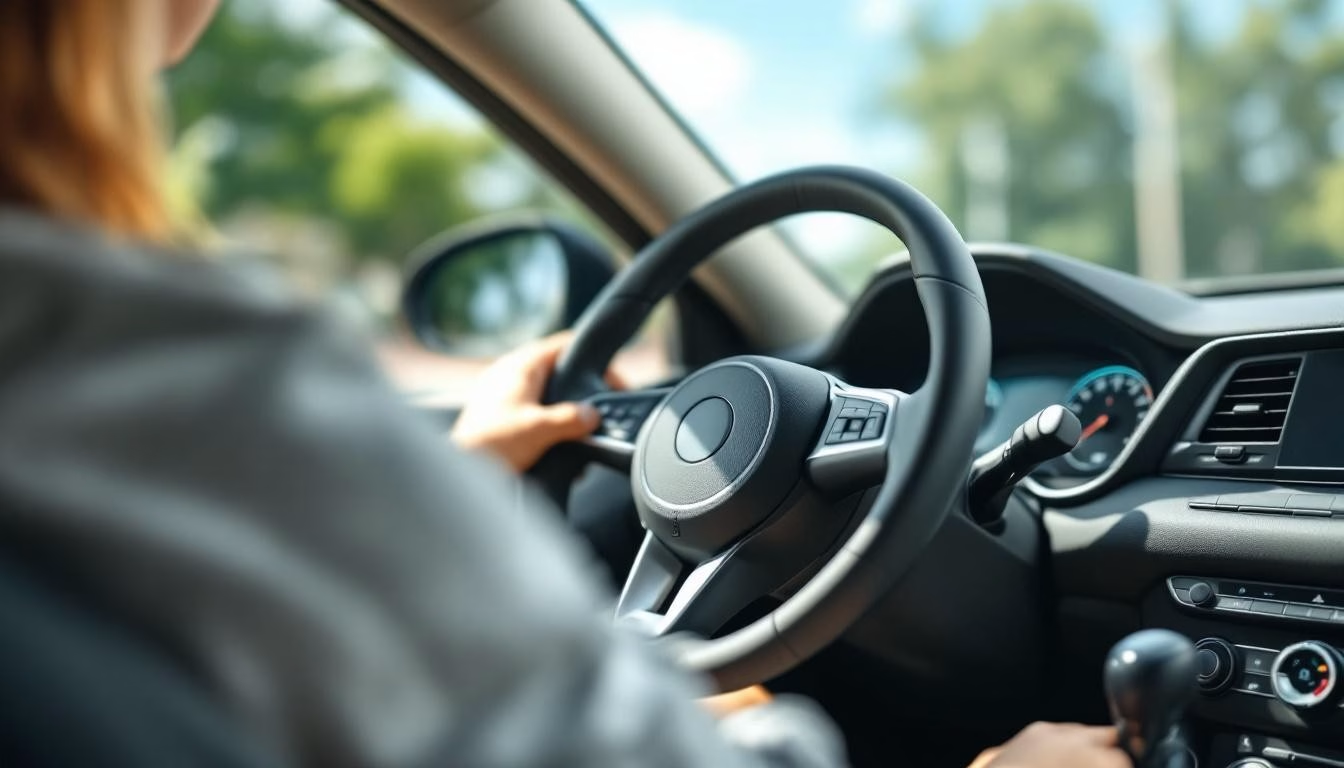
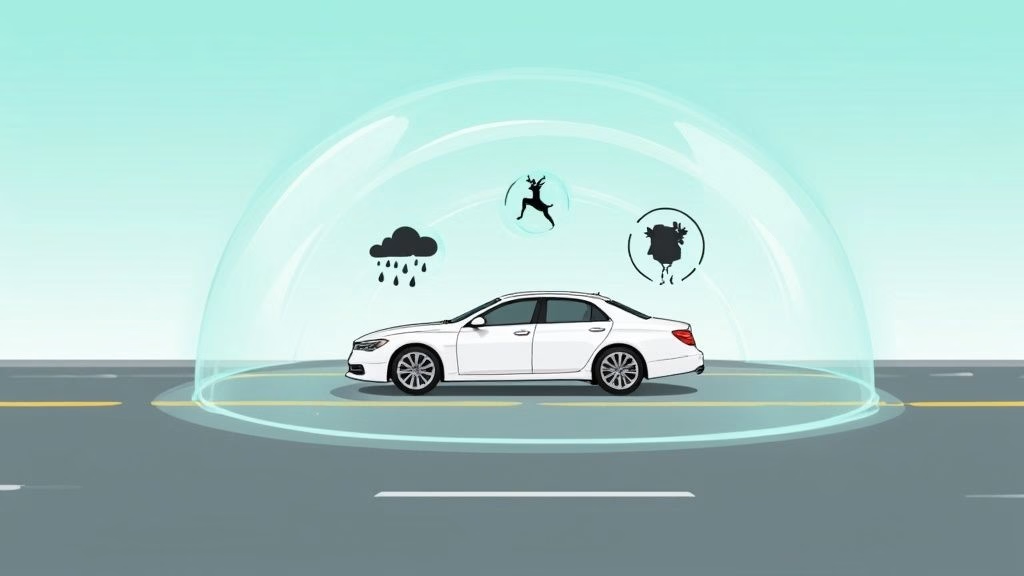



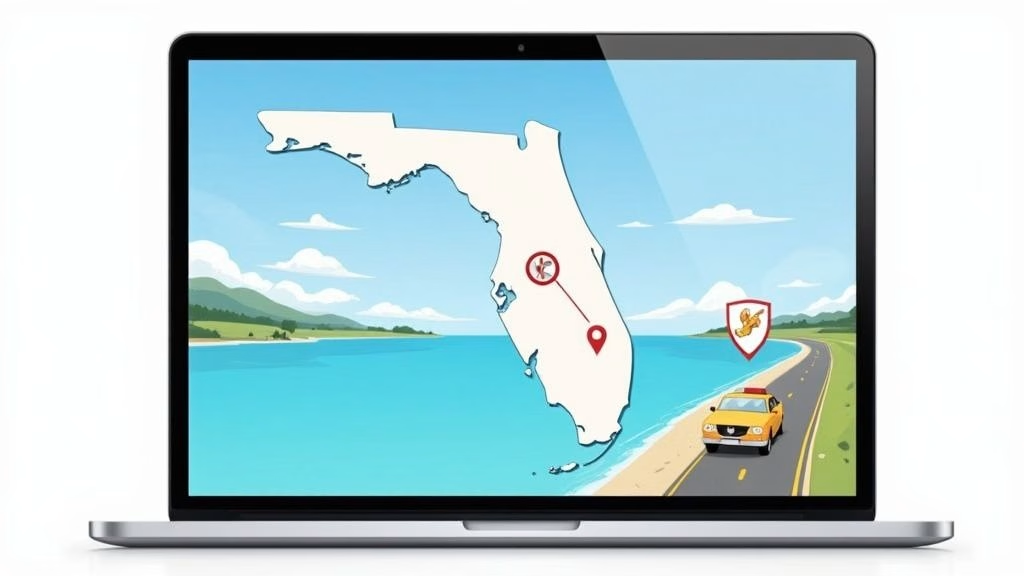
![The Best Online Traffic Schools in Florida [2025]](https://floridanewdriver.com/wp-content/uploads/emplibot/online-traffic-school-florida-hero-1765422499.avif)